

In December 2012, the NOAA National Geophysical Data Center and the NASA Earth Observatory released a new map of the Earth as it appears at night. Built with data from the Visible Infrared Imaging Radiometer Suite (VIIRS) on the Suomi NPP satellite, this revision to the iconic “night lights” map offered better clarity and resolution than ever before, and much more sensitivity to light.
It also offered several surprises. VIIRS detected an abundance of human activity amidst the rural natural gas fields of North Dakota. It found extensive light in the bush country of Western Australia, where most people thought there should be none.
And then VIIRS found something fishy off the coast of Argentina.
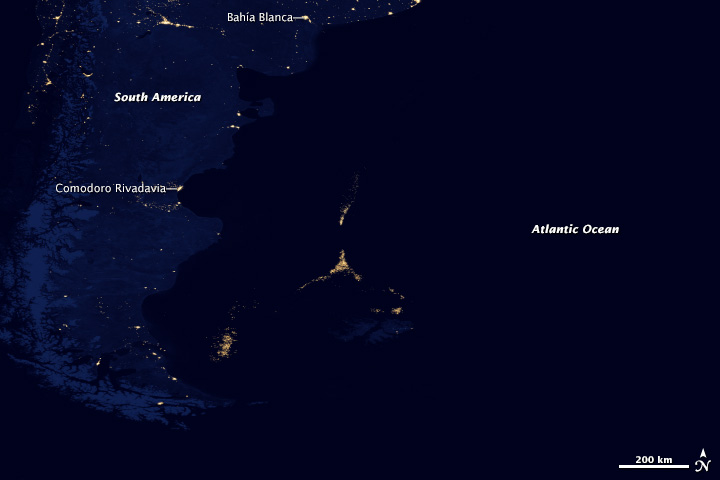
In 2012, a global composite map of Earth’s night lights revealed human activity well offshore from South America. (NASA Earth Observatory/NOAA National Geophysical Data Center)
About 300 to 500 kilometers (200 to 300 miles) offshore, a city of light appeared in the middle of the South Atlantic Ocean. There are no human settlements there, nor fires or gas wells. But there are an awful lot of fishing boats.
Adorned with lights for night fishing, the boats cluster offshore along invisible lines: the underwater edge of the continental shelf, the nutrient-rich Malvinas Current, and the boundaries of the exclusive economic zones of Argentina and the Falkland Islands.
The night fishermen are hunting for Illex argentinus, a species of short-finned squid that forms the second largest squid fishery on the planet. The squid are found tens to hundreds of kilometers offshore from roughly Rio de Janeiro to Tierra del Fuego (22 to 54 degrees South latitude). They live 80 to 600 meters (250 to 2,000 feet) below the surface, feeding on shrimp, crabs, and fish. In turn, Illex are consumed by larger finfish, whales, seals, sea birds, penguins...and humans.
The fishery is fueled by abundant nutrients and plankton carried on the Malvinas Current. Spun off of the Circumpolar Current of the Southern Ocean, the Malvinas flows north and east along the South American coast. The waters are enriched by iron and other nutrients from Antarctica and Patagonia, and they are made even richer by the interaction of ocean currents along the shelfbreak front, where the continental shelf slopes down to the deep ocean abyssal plain.
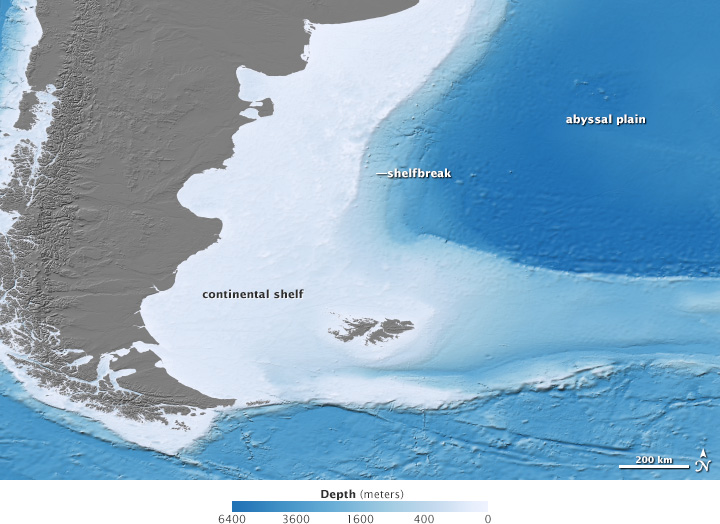
Seafloor maps show the shelfbreak, where the continental shelf drops to the deep ocean. The shape of the ocean floor and the patterns of ocean currents above make for productive fishing grounds. (Global Bathmetric Chart of the Oceans, British Oceanographic Data Center)
In the bathymetric map above, the brighter areas show the relatively shallow waters (tens to hundreds of meters depth) of the continental shelf, while darker blues depict deeper water (hundreds to thousands of meters). The shelfbreak is the southwest to northeast ridge between the two.
“Squid aggregate in high concentrations at the shelfbreak because it is a very productive area during austral spring and summer,” said Marina Marrari, a biological oceanographer with Argentina’s Servicio de Hidrografia Naval (Hydrographic Service). At the shelfbreak front, microscopic plant-like organisms—phytoplankton—explode in population in various seasons. This “grass of the sea” feeds zooplankton and fish, which then become food for Illex argentinus and other marine creatures.
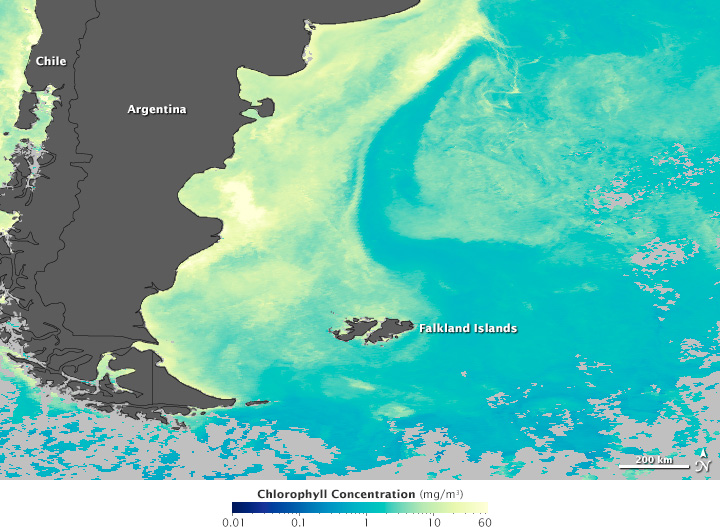
Daytime chlorophyll concentrations on the South Atlantic Ocean surface reveal the presence of phytoplankton, which draw squid, fish, and other marine creatures to the area for feeding. (Map by the NASA Ocean Color Group using VIIRS data.)
The map above shows the distribution of chlorophyll in March 2012 along the coast of South America. The amount of chlorophyll is a measure of how much phytoplankton is growing near the sea surface. Brighter whites and yellows show the areas with the highest concentrations; blues and green have low concentrations of chlorophyll.
Working in these high chlorophyll areas, fishermen from South America and Southeastern Asia light up the ocean with powerful lamps that attract the plankton and fish species that the squid feed on. The squid follow their prey toward the surface, where they are easier for fishermen to catch with jigging lines. Squid boats can carry more than a hundred of these lamps, generating as much as 300 kilowatts of light per boat.

Squid fishermen use bright lights to draw fish and squid toward the sea surface at night. (©2012 Jay Lawler)
Scientists first noted such night-lighting of the seas in the late 1970s and early 1980s, while compiling the first maps of the Earth at night. The images from the Operational Linescan System on the polar-orbiting satellites of the Defense Meteorological Satellite Program (DMSP) clearly showed fishing boats working the waters off of Japan, China, and Korea.
Chris Elvidge, who leads the Earth Observation Group at NOAA’s National Geophysical Data Center, notes that fisheries agencies in Thailand, Peru, South Korea, Japan, Argentina, and Britain regularly request DMSP and VIIRS/Suomi data for monitoring fishing activity. NASA oceanographer Gene Feldman noted that some scientists also track natural ocean phenomena with the lights. For instance, eddies in the Cook Strait (off New Zealand) can sometimes be outlined by fishing boats working the edges of these swirling, fertile masses of water and nutrients.
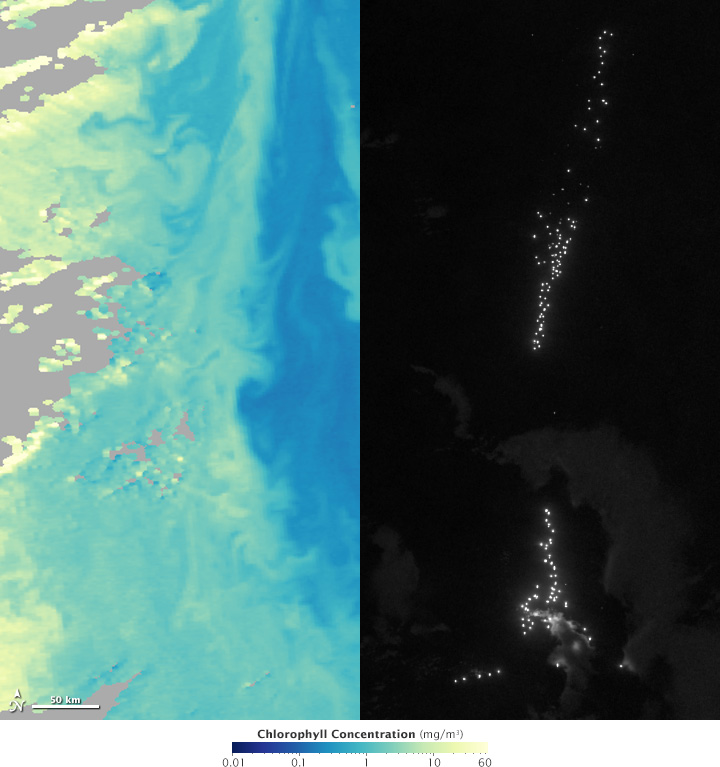
On April 18 and 19, 2012, daytime chlorophyll concentrations (left) and nighttime ocean lighting (right) line up in the South Atlantic. (Map by NASA Earth Observatory, using data from the NASA Ocean Color Group and the VIIRS day-night band on Suomi NPP.)
The maps above show chlorophyll concentrations off Argentina and the Falkland Islands on April 18, 2012 (left), and fishing boat locations on the early morning hours of April 19, 2012 (right). Note how the lights line up not just with the chlorophyll (plankton), but also in a wishbone or upside-down Y shape. (Note: gray marks areas with no chlorophyll data that day.)
In the South Atlantic, Argentine and Falklands citizens have exclusive rights to fish out to 320 kilometers (200 miles). As the images suggest, ships from other nations work as close to that border as they can to get a share of the squid fishing.
Officially, about 100 boats receive permits each year to work the squid fishery; satellite images suggest that many more are out there, though. The map below shows the locations of fishing boats on nine consecutive nights from April 17 to 25, 2012. (Lights appear sharper on some nights and more diffuse on others due to the presence or absence of cloud cover and fog.) In addition to the fishing boats, large refrigeration and refueling ships keep the long-distance operators working without having to go back to a port.
“The satellite images are a tool to understand what is happening with the fishery, especially in international waters,” said Ezequiel Cozzolino of El Instituto Nacional de Investigación y Desarrollo Pesquero (Argentina’s national fisheries research institute). “The images allow us to estimate the number of foreign jigging fleets that are fishing Illex argentinus, and to calculate the weekly captures of the species.”
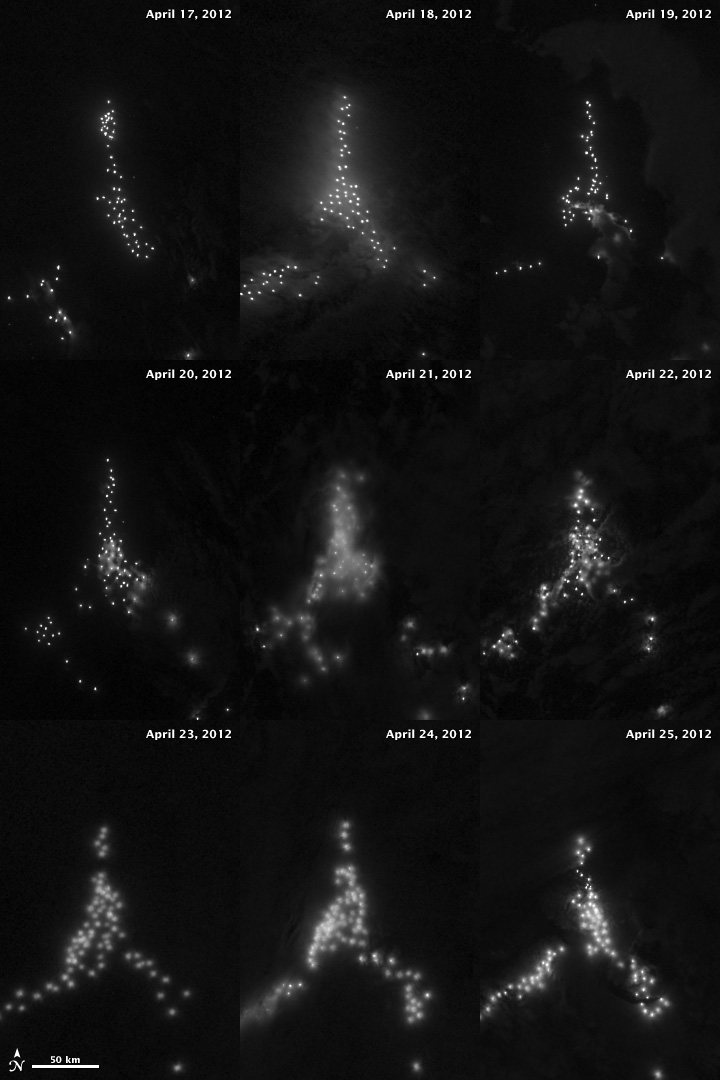
Over the course of nine nights, fishing boats shift positions while hugging the borders of the exclusive economic zones of Argentina and the Falkland Islands. (Map by NASA Earth Observatory, using VIIRS day-night band data from Suomi NPP.)
Fisheries researchers and managers suggest that as much as 300,000 tons of Illex squid are harvested from the South Atlantic each year by unlicensed, unregulated fishing vessels. Managing the fishery and monitoring the presence of foreign fishing fleets is very difficult for navies and fisheries managers; the satellite views provide at least some sense of the activity in the area.
“These lights help reveal the full range, patterns, and night-to-night variability of these fishing activities in striking detail,” said Steve Miller, a Colorado State University scientist who works with VIIRS nighttime imagery. “It’s just another example of how much information exists in night lights measurements and how unique they are for coupling human activity with the natural environment in a way that conventional visible imagery cannot do.”